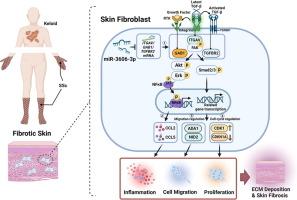当前位置:
X-MOL 学术
›
J. Adv. Res.
›
论文详情
Our official English website, www.x-mol.net, welcomes your
feedback! (Note: you will need to create a separate account there.)
miR-3606-3p alleviates skin fibrosis by integratively suppressing the integrin/FAK, p-AKT/p-ERK, and TGF-β signaling cascades
Journal of Advanced Research ( IF 11.4 ) Pub Date : 2024-11-20 , DOI: 10.1016/j.jare.2024.11.027 Yahui Chen, Yiyi Gong, Mengkun Shi, Haoxing Zhu, Yulong Tang, Delin Huang, Wei Wang, Chenyi Shi, Xueyi Xia, Ying Zhang, Jianlan Liu, Jia Huang, Mengguo Liu, Huyan Chen, Yanyun Ma, Ziyu Wang, Lei Wang, Wenzhen Tu, Yinhuan Zhao, Jinran Lin, Li Jin, Jörg HW Distler, Wenyu Wu, Jiucun Wang, Xiangguang Shi
Journal of Advanced Research ( IF 11.4 ) Pub Date : 2024-11-20 , DOI: 10.1016/j.jare.2024.11.027 Yahui Chen, Yiyi Gong, Mengkun Shi, Haoxing Zhu, Yulong Tang, Delin Huang, Wei Wang, Chenyi Shi, Xueyi Xia, Ying Zhang, Jianlan Liu, Jia Huang, Mengguo Liu, Huyan Chen, Yanyun Ma, Ziyu Wang, Lei Wang, Wenzhen Tu, Yinhuan Zhao, Jinran Lin, Li Jin, Jörg HW Distler, Wenyu Wu, Jiucun Wang, Xiangguang Shi

|
Fibroblast abnormalities are crucial causes of skin fibrosis, including systemic sclerosis (SSc) and keloids. However, their mechanisms, including underlying microRNA regulatory mechanisms, remain elusive.
中文翻译:

miR-3606-3p 通过整合抑制整合素/FAK、p-AKT/p-ERK 和 TGF-β 信号级联反应来缓解皮肤纤维化
成纤维细胞异常是皮肤纤维化的关键原因,包括系统性硬化症 (SSc) 和瘢痕疙瘩。然而,它们的机制,包括潜在的 microRNA 调节机制,仍然难以捉摸。
更新日期:2024-11-20
中文翻译:

miR-3606-3p 通过整合抑制整合素/FAK、p-AKT/p-ERK 和 TGF-β 信号级联反应来缓解皮肤纤维化
成纤维细胞异常是皮肤纤维化的关键原因,包括系统性硬化症 (SSc) 和瘢痕疙瘩。然而,它们的机制,包括潜在的 microRNA 调节机制,仍然难以捉摸。






























 京公网安备 11010802027423号
京公网安备 11010802027423号